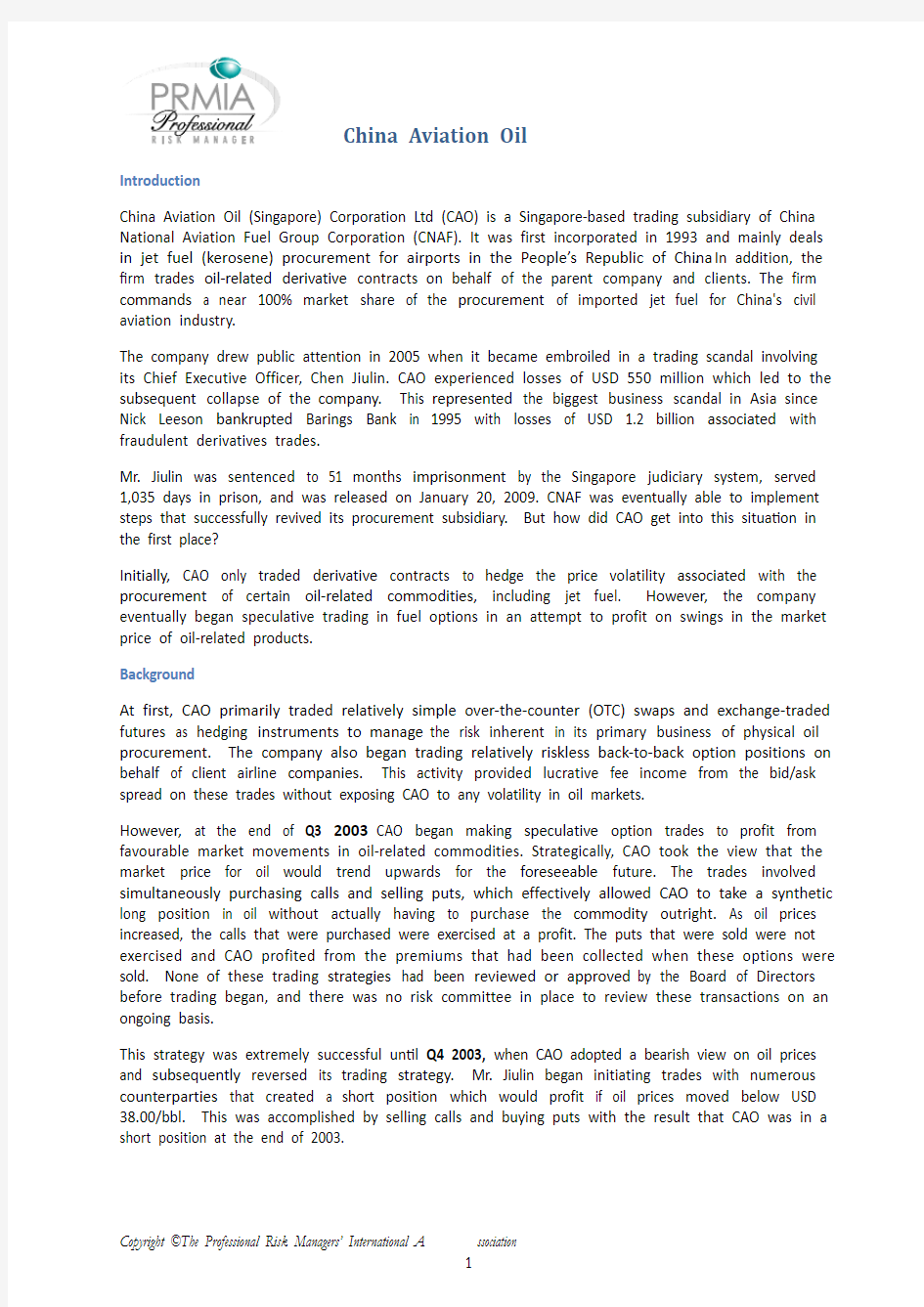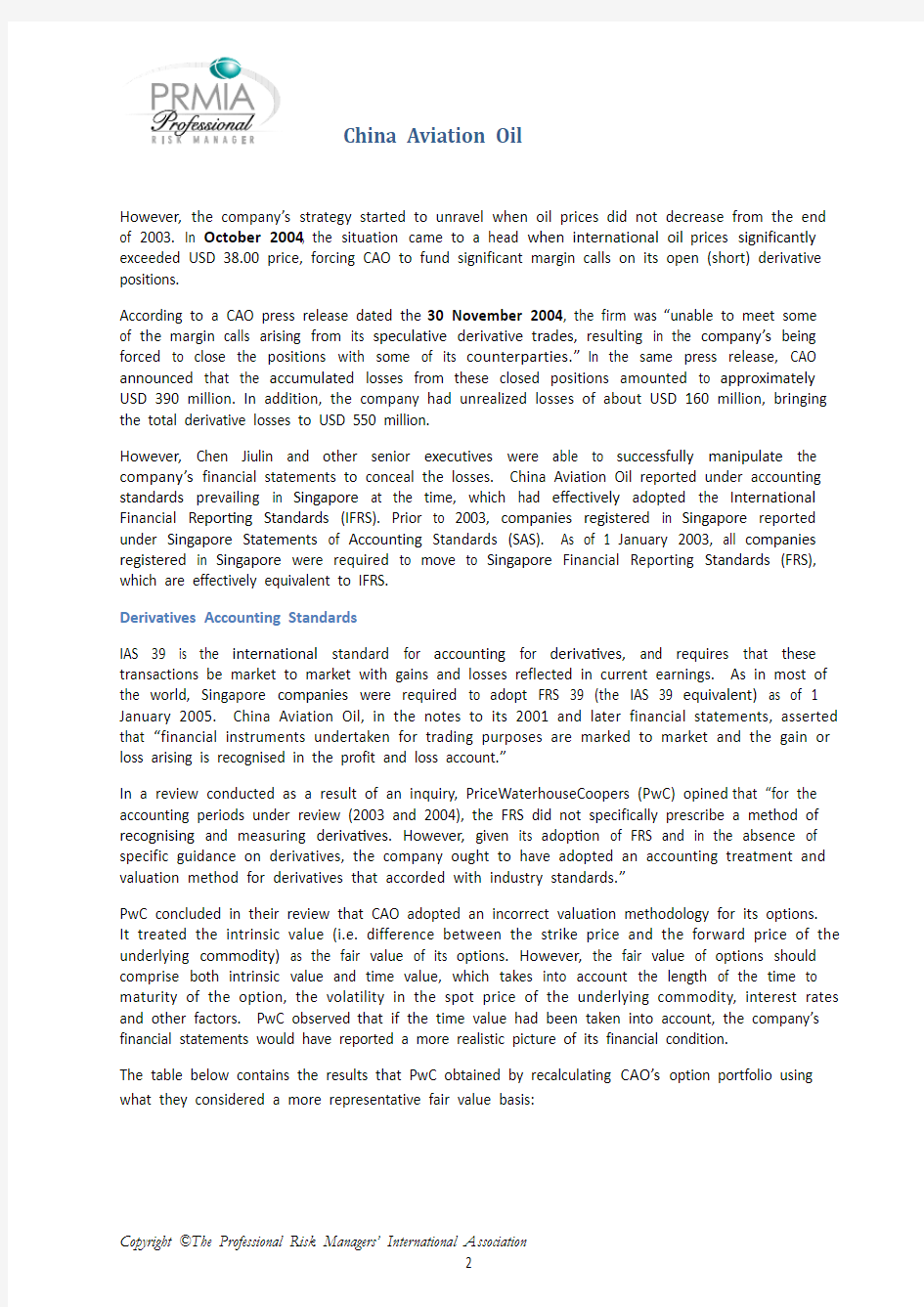ChinaAviationOil_2012.03.30


Introduction
China Aviation Oil (Singapore) Corporation Ltd (CAO) is a Singapore-based trading subsidiary of China National Aviation Fuel Group Corporation (CNAF). It was first incorporated in 1993 and mainly deals in jet fuel (kerosene) procurement for airports in the People’s Republic of China. In addition, the firm trades oil-related derivative contracts on behalf of the parent company and clients. The firm commands a near 100% market share of the procurement of imported jet fuel for China's civil aviation industry.
The company drew public attention in 2005 when it became embroiled in a trading scandal involving its Chief Executive Officer, Chen Jiulin. CAO experienced losses of USD 550 million which led to the subsequent collapse of the company. This represented the biggest business scandal in Asia since Nick Leeson bankrupted Barings Bank in 1995 with losses of USD 1.2 billion associated with fraudulent derivatives trades.
Mr. Jiulin was sentenced to 51 months imprisonment by the Singapore judiciary system, served 1,035 days in prison, and was released on January 20, 2009. CNAF was eventually able to implement steps that successfully revived its procurement subsidiary. But how did CAO get into this situation in the first place?
Initially, CAO only traded derivative contracts to hedge the price volatility associated with the procurement of certain oil-related commodities, including jet fuel. However, the company eventually began speculative trading in fuel options in an attempt to profit on swings in the market price of oil-related products.
Background
At first, CAO primarily traded relatively simple over-the-counter (OTC) swaps and exchange-traded futures as hedging instruments to manage the risk inherent in its primary business of physical oil procurement. The company also began trading relatively riskless back-to-back option positions on behalf of client airline companies. This activity provided lucrative fee income from the bid/ask spread on these trades without exposing CAO to any volatility in oil markets.
However, at the end of Q3 2003CAO began making speculative option trades to profit from favourable market movements in oil-related commodities. Strategically, CAO took the view that the market price for oil would trend upwards for the foreseeable future. The trades involved simultaneously purchasing calls and selling puts, which effectively allowed CAO to take a synthetic long position in oil without actually having to purchase the commodity outright. As oil prices increased, the calls that were purchased were exercised at a profit. The puts that were sold were not exercised and CAO profited from the premiums that had been collected when these options were sold. None of these trading strategies had been reviewed or approved by the Board of Directors before trading began, and there was no risk committee in place to review these transactions on an ongoing basis.
This strategy was extremely successful until Q4 2003, when CAO adopted a bearish view on oil prices and subsequently reversed its trading strategy. Mr. Jiulin began initiating trades with numerous counterparties that created a short position which would profit if oil prices moved below USD 38.00/bbl. This was accomplished by selling calls and buying puts with the result that CAO was in a short position at the end of 2003.
However, the company’s strategy started to unravel when oil prices did not decrease from the end of 2003. In October 2004, the situation came to a head when international oil prices significantly exceeded USD 38.00 price, forcing CAO to fund significant margin calls on its open (short) derivative positions.
According to a CAO press release dated the 30 November 2004, the firm was “unable to meet some of the margin calls arising from its speculative derivative trades, resulting in the company’s being forced to close the positions with some of its counterparties.”In the same press release, CAO announced that the accumulated losses from these closed positions amounted to approximately USD 390 million. In addition, the company had unrealized losses of about USD 160 million, bringing the total derivative losses to USD 550 million.
However, Chen Jiulin and other senior executives were able to successfully manipulate the company’s financial statements to conceal the losses. China Aviation Oil reported under accounting standards prevailing in Singapore at the time, which had effectively adopted the International Financial Reporting Standards (IFRS). Prior to 2003, companies registered in Singapore reported under Singapore Statements of Accounting Standards (SAS). As of 1 January 2003, all companies registered in Singapore were required to move to Singapore Financial Reporting Standards (FRS), which are effectively equivalent to IFRS.
Derivatives Accounting Standards
IAS 39 is the international standard for accounting for derivatives, and requires that these transactions be market to market with gains and losses reflected in current earnings. As in most of the world, Singapore companies were required to adopt FRS 39 (the IAS 39 equivalent) as of 1 January 2005. China Aviation Oil, in the notes to its 2001 and later financial statements, asserted that “financial instruments undertaken for trading purposes are marked to market and the gain or loss arising is recognised in the profit and loss account.”
In a review conducted as a result of an inquiry, PriceWaterhouseCoopers (PwC) opined that “for the accounting periods under review (2003 and 2004), the FRS did not specifically prescribe a method of recognising and measuring derivatives. However, given its adoption of FRS and in the absence of specific guidance on derivatives, the company ought to have adopted an accounting treatment and valuation method for derivatives that accorded with industry standards.”
PwC concluded in their review that CAO adopted an incorrect valuation methodology for its options. It treated the intrinsic value (i.e. difference between the strike price and the forward price of the underlying commodity) as the fair value of its options. However, the fair value of options should comprise both intrinsic value and time value, which takes into account the length of the time to maturity of the option, the volatility in the spot price of the underlying commodity, interest rates and other factors. PwC observed that if the time value had been taken into account, the company’s financial statements would have reported a more realistic picture of its financial condition.
The table below contains the results that PwC obtained by recalculating CAO’s option portfolio using what they considered a more representative fair value basis:
TABLE 1: China Aviation Oil – Reported vs. Adjusted Earnings (2004, USD millions)
Source: PriceWaterhouseCoopers Report, 3 June 2005
PwC concluded that the “company’s reported earnings in 2004 were therefore grossly inaccurate.”Due to the steady rise in oil prices during 2004, even a fair value approach based purely on intrinsic value should have shown significant losses at China Aviation Oil in 2004. However, according to PwC’s report, to avoid recording and reporting losses the company adopted a risky strategy to sell long-term options to generate premiums that would cover the cost of closing out the loss-making option contracts. In effect, CAO was trying to compensate for their existing losses by collecting premiums on options that had the potential to generate further losses in the future.
Timeline of Events
?March 2003– CAO enters into speculative option trades on crude oil reflecting a bullish view on oil prices
?Q4 2003–CAO changes its strategy and starts trading speculative options that reflect a bearish view on oil prices.
?October 2004 -International oil prices rise steeply, leaving CAO facing significant margin calls on its open (short) derivative positions.
?November 2004 –In a press release CAO states that it is unable to meet some of the margin calls arising from its speculative derivative trades, res ulting in the company’s being forced to close the positions with some of its counterparties. The accumulated losses from these closed positions amount to approximately USD 390 million. In addition, the company had unrealized losses of about USD 160 million, bringing the total derivative losses to USD 550 million.
?March 2006 - Chen Jiulin is arrested and charged with insider trading, and was sentenced to
51 months imprisonment.
How the Collapse Occurred
CAO did not have properly defined risk management policies in place when the speculative option trading started and there was a lack of oversight by the senior management. The option contracts, some of which had complex features such as maturity extensions, were not valued according to best practices. CAO continued with its valuation approach using only intrinsic value even though trade confirmations obtained from counterparties contained significantly different prices. In addition, losses were exacerbated by selling large numbers of risky option contracts to generate premium income in an attempt to cover existing losses on closed positions.
Lessons to be Learned
Many issues and problems were exposed as a result of the CAO scandal, including concerns about corporate governance, market monitoring and surveillance, compliance and regulation, inadequate knowledge in risk management, and incomplete assessments of risk.
There are many lessons to be learned from this case:
?The strategic objectives and risk management policy of the company must be determined at the highest level in the organisation
?Senior management must ensure that the policies are incorporated into daily operations and dedicate the necessary resources to achieve this
? A risk management department must be set up to:
o ensure open derivative positions are monitored;
o ensure compliance with policies and procedures;
o assess other risks related to the activity, e.g. margin requirements.
?Internal and external reporting (financial statements) must follow best practice with frequent and detailed disclosures.
?There should be regular stress testing for derivative positions using risk models
?Prior to trading in new products, a formal analysis should be conducted and documented addressing the risk profile of the product, the appropriateness of its use, the ability to handle the new product operationally, and the appropriate accounting treatment. Conclusions
Derivatives disasters generally have little to do with the inherent risky character of derivative instruments. In CAO’s case the losses from speculative oil derivative trades were due in part to the company’s desire not to disclose losses in 2004 as well as improper risk management procedures and the failure of senior management to provide adequate oversight.
Sources:
Report by PwC on its investigation into the oil trading losses - available from the China Aviation Oil website (go to news release for June 3rd, 2005).
Deloitte, “The China Aviation Oil Debacle”, published January 2006.
Serge Matulich, David M. Currie, “Handbook of Frauds, Scams, and Swindles”, published in 2008.
Alan N. Peachey, “Great Financial Disasters of our Time”, published in 2006.
